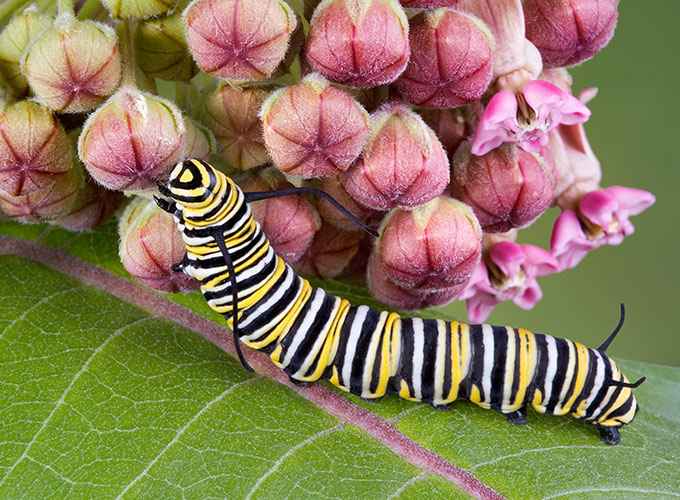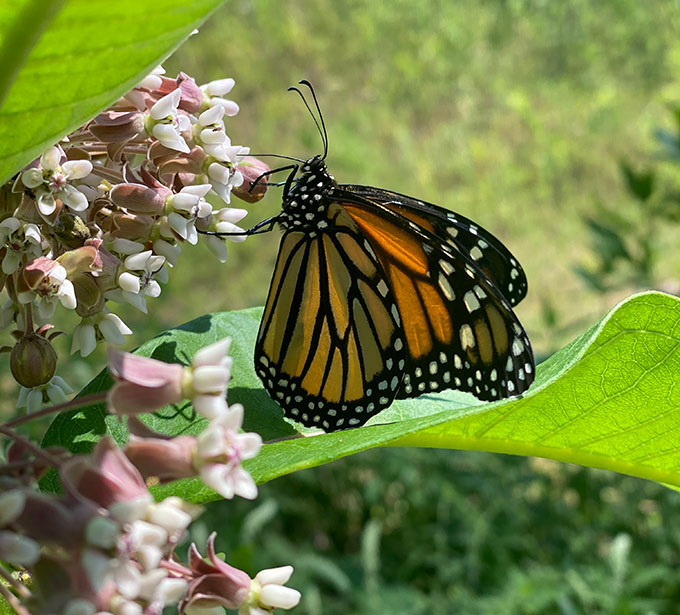Pesticides contaminate most food of western U.S. monarchs
Poisoned milkweed plants may be killing off this butterfly, at least regionally, scientists worry

Monarch butterflies depend on milkweed plants for their survival. But new research finds that in California, milkweeds are often contaminated with pesticides.
rainbow-7/iStock/Getty Images Plus
Share this:
- Share via email (Opens in new window) Email
- Click to share on Facebook (Opens in new window) Facebook
- Click to share on X (Opens in new window) X
- Click to share on Pinterest (Opens in new window) Pinterest
- Click to share on Reddit (Opens in new window) Reddit
- Share to Google Classroom (Opens in new window) Google Classroom
- Click to print (Opens in new window) Print
Each fall, the California coast welcomes large numbers of North America’s monarch butterflies. It’s the spectacular fall migration for these butterflies in the West. In the past, millions of the brightly colored insects gathered in groves of California trees to spend the winter. Here they’d be safe from the cold. But over the last few decades, numbers of these western monarchs have fallen sharply. Poisoning may partly explain this loss, a new study finds.
Compared to the 1980s, only one percent as many monarchs winter in California now. Milkweed plants are the one food on which monarch caterpillars dine. And California’s milkweeds are widely contaminated with pesticides, new data show. Indeed, every milkweed plant sampled had pesticides.
North America’s monarch butterflies fall into two groups. The western group lives west of the Rocky Mountains. These winter in California. A separate eastern group lives east of the Rockies and winters in central Mexico.
For both groups, fewer monarchs have been arriving at their winter homes than a few decades ago. But the loss in California has been especially bad. Millions of western monarchs used to arrive each winter. In 2018, fewer than 29,000 butterflies showed up. The new study looked at whether pesticides might play a role.
People use toxic chemicals to kill off different types of pests. These range from insects and fungi to weeds. Pesticides also can poison non-pests. Scientists had worried that such pollutants might be harming monarchs. But no one knew how much exposure these insects faced.
To find out, a team of scientists focused on California’s Central Valley. It’s home to cities, towns and natural areas. It’s best known, however, for its farmland. More than half of the fruits, vegetables and nuts sold in the United States are grown here, often using pesticides. This valley also makes up a critical part of the monarch’s California breeding grounds.
The researchers sampled more than 200 milkweed plants across the Central Valley. Some came from farms. Others were growing on roadsides, in yards and in wild areas. Some even came from garden stores. The team tested the plants for a wide range of pesticides. These included ones that target insects, fungi and weeds.
The pivotal role of milkweed plants
In spring, western monarchs leave the California coast to fan out across western states and southwestern Canada. They lay eggs on milkweed plants as they go. “Monarch caterpillars only feed on milkweed,” notes Sarah Hoyle. “So these plants are a critical resource for monarchs,” explains this pesticide expert. She works for the Xerces Society for Invertebrate Conservation in Portland, Ore.
When a caterpillar hatches, it munches milkweed leaves and grows plump. After a few weeks, that larval insect wraps itself in a jade green covering. In this stage, known as a pupa, the caterpillar morphs into a butterfly. After the adult emerges, it drinks nectar from flowers and mates. If it is female, she will lay her eggs on milkweeds, and the cycle will start again.

In early fall, the last of the adults emerge. These fall monarchs don’t mate or lay eggs like the summer ones. Instead, they migrate, flying south to escape the cold. If they survive the journey, the western ones will arrive along the California coast in September and October. But each year, fewer and fewer monarchs have been showing up.
Something has caused their numbers to shrink. A change to any part of the yearly cycle could be to blame.
The new study looked at a possible role for pesticides. The scientists identified 64 different pesticides on their milkweed samples. The average plant contained nine. Some had as many as 25. Nearly one in every three of the plants had pesticide levels known to be lethal to monarchs. The scientists shared their findings June 8 in Frontiers in Ecology and Evolution.
“We were surprised that we found pesticides in all of the samples,” says Hoyle. “Everywhere we looked — home gardens, parks, agricultural lands, wildlife refuges — pesticides were present.”
A previous study revealed that pesticides taint milkweeds in agricultural areas of the eastern monarchs’ range as well.

“This shows that pesticides are moving on the landscape,” says Christopher Halsch. He is a biologist at the University of Nevada, Reno. He took part in the new study. A concern, he says, is that winds or rains can move the pesticides far from where they were applied.
The highest levels of pesticides were found on milkweeds for sale at garden stores. Why? Garden stores want their plants to look appealing, Halsch notes, and “one way to help with this is to apply chemicals.” But people who buy milkweed plants often don’t know they had been treated with pesticides.
Ian Kaplan said he was struck that so many different pesticides showed up in so many places. As an entomologist, he is a scientist who studies insects. He works at Purdue University in West Lafayette, Ind., and did not take part in the new study. More testing is needed to learn how the different pesticides affect a caterpillar or the adult butterfly, he cautions. For most of them, he points out, “We don’t know what they do to monarchs.”
Monarchs may also face other risks
The findings raise fresh concerns about whether pesticides could be putting monarchs at risk. However, pesticides are unlikely to be the only cause for the monarchs’ decline, Halsch and Hoyle note. Both habitat loss and climate change also could pose risks.
The new findings point to the need for stronger action to limit pesticide contamination, argues Hoyle. “We can all play a role in reducing pesticide use,” she says. Many people are planting milkweed plants to feed monarch caterpillars. If now appears essential to ask garden stores if their plants were grown without the use of long-lasting pesticides, she says. That way your gardens can host milkweeds without accidentally harming monarch caterpillars.







